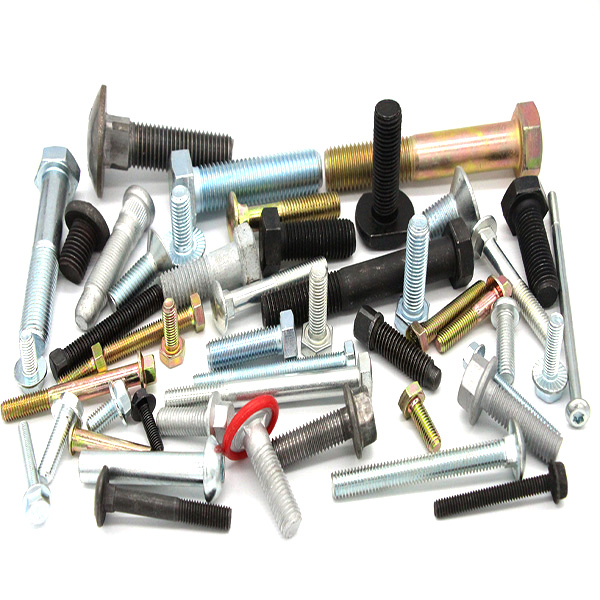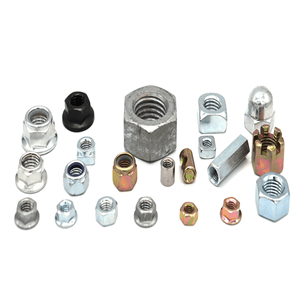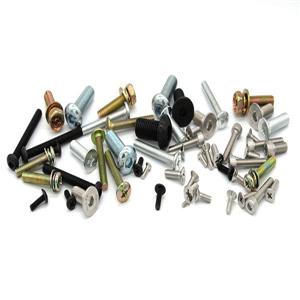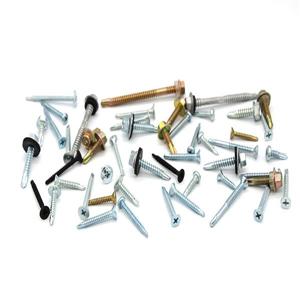Do you know about fastener materials?
Do you know about fastener materials?
1) Carbon steel
Carbon steel has excellent processability, can meet a wide range of strength performance combinations, and has a lower cost compared to other fastener materials.
The mechanical properties of carbon steel are sensitive to carbon content, which is usually less than 1.0%. For fasteners, ordinary steel is divided into three types: low carbon steel, medium carbon steel and alloy steel.
2) Low-carbon steel
The carbon content of low carbon steel is usually lower than 0.25%, and the strength cannot be improved by heat treatment; the strength can only be improved by cold work hardening. Low-carbon steel is relatively soft and weak, but has excellent ductility and toughness. In addition, it has easy processability and weldability, and relatively low production costs. For example, the low-carbon material has a yield strength of 40,000 psi, a tensile strength of 60,000 to 80,000 psi, and a ductility of 25% EL. The most commonly used materials are the 1006, 1008, 1016, 1018, 1021 and 1022 grades specified by the AISI American Iron and Steel Institute standard.
The SAEJ 429 standard, Grade 1 and ASTM A 307 Grade A, are essentially the same, and are standards for the strength of low carbon steel. ASTM A 307 grade B is a special mild steel grade suitable for mild steel bolts on fittings and flanges. Its performance is basically the same as Grade A, except that a special maximum tensile strength is specified. This is to ensure that if over-tightening issues occur during installation, the bolts will be broken before damaging flanges, valves and pipes. SAE J 429 Grade 2 is a low-carbon steel grade that has been cold-work hardened to increase strength.
3) Mild-Carbon steel
The carbon content of medium carbon steel is 0.25 ~ 0.6% (mass fraction). Such steels can be improved in mechanical properties by heat treatment methods such as austenitizing, quenching and tempering. Ordinary medium carbon steel has poor hardenability. It must have a small cross section to fully harden, and it needs to be quenched during quenching. This means that the final performance of the fastener depends on its size. Please note that in SAE J 429 Grade 5, ASTM A325 and ASTM A 449, the strength properties gradually "degrade" as the diameter increases.
In terms of strength-to-cost ratio, heat-treated medium carbon steel parts have excellent load-carrying capacity and a low yield ratio; they also have good toughness. Commonly used materials are AISI American Iron and Steel Institute standards 1030, 1035, 1038, and 1541.
4) Alloy steel
When the carbon steel contains more than 1.65% manganese, or the content of silicon or copper exceeds 0.6%, or the chromium content does not exceed 4%, it can be called alloy steel. In addition, when carbon steel is added with a specified minimum content of components such as aluminum, titanium, vanadium, nickel or other elements to meet certain performance requirements, it is also called an alloy. The addition of chromium, nickel and molybdenum can improve the strength and ductility of the alloy steel after heat treatment.
SAEJ 429 grade 8, ASTM A 354 grade BD, ASTMA 490, ASTM A 193 B7 are all common alloy steel fasteners.

5) Stainless steel
Stainless steel is an iron-based alloy steel with a chromium content of more than 10.5%. The presence of chromium creates an invisible film on the surface of the steel, which prevents oxidation and "passivates" or resists corrosion. Adding other elements such as nickel or molybdenum can improve corrosion resistance, strength and temperature resistance.
Stainless steel can be divided into three types according to its metallographic structure: austenite, martensite, and ferrite. Each category has its own characteristics and is also broken down into several levels or types. In addition, in order to meet the needs of different corrosion conditions, temperature ranges, strength requirements, welding performance, machining cutting performance, cold hardening and forming ability, etc., new alloy steels can be further developed by changing the chemical composition.
Austenitic stainless steels have higher levels of chromium and nickel than other types of stainless steel. Austenitic stainless steels cannot be hardened by heat treatment. But it has higher corrosion resistance. Generally not magnetic; however, some parts may become slightly magnetic after the cold working process. The tensile strength of austenite is 75,000-105,000 psi.
18-8 stainless steel is a typical type of austenitic stainless steel and contains approximately 18% chromium and 8% nickel. 18-8 stainless steel includes grades 302, 303, 304 and XM7.
Common austenitic stainless steel grades:
· 302: commonly used stainless steel, the surface is matte under general atmospheric conditions, and still has high strength at quite high temperatures. With corrosion resistance. After processing, it has higher strength. Usually used as steel wire products, such as: springs, screens, steel cables, etc. It is also commonly used as a flat washer.
· 302HQ: Specially added copper element reduces the effect of cold hardening, making it easy to cold-cold processing. Commonly used for machine screws, metal screws and small nuts.
· 303: Contains a small amount of sulfur and has good machining performance. It is often used to process non-standard bolts and nuts.
· 304: Low carbon high chromium stainless steel, which has better corrosion resistance compared to 302. 304 is the most commonly used stainless steel for hexagon head bolts. It is usually processed by cold heading, and hot heading is also commonly used for large diameter or long specifications Way processing.
304L: The carbon content is lower than 304, so the strength is slightly lower. The low carbon content also makes it very resistant to corrosion and welding.
· 309 & 310: The content of nickel and chromium is higher than the above-mentioned low-grade steels, and it is recommended to be used under high temperature conditions. 310 is very resistant to salt water and other harsh environments.
· 316 and 317: Excellent resistance to seawater and many chemicals, because it contains molybdenum, it has a good resistance to surface pitting corrosion. These steels have higher tensile and creep strengths than other austenitic steels at high temperatures.
Limitations of austenitic stainless steel:
· Applicable only to low-concentration weak acids.
· In gaps and closed places, there may not be enough oxygen to maintain the passivation film, which may cause gap corrosion.
· High concentrations of halogen ions, especially chloride ions, can damage the passivation film.
After heat treatment of martensitic stainless steel, its metallographic structure is mainly martensitic. This type of stainless steel contains 12 ~ 18% chromium. Heat treatment can be used to improve hardness, poor welding performance, and magnetic properties. Martensitic stainless steel has a tensile strength of approximately 70,000 to 145,000 psi. This type of stainless steel is suitable for low corrosive environments.
Common martensitic stainless steel grades:
· 410: Pure chrome alloy material without nickel. It is a corrosion-resistant, heat-resistant chrome steel that can be hardened. It is easy to upset and has good machinability. Due to its high hardness, it is mainly used to make self-tapping and self-drilling screws. Compared with 300 series stainless steel, its corrosion resistance is quite poor.
· 416: It is similar to 410 material except that the chromium content is slightly higher, so it has better machining performance, but the corrosion resistance is worse than 410.
Ferritic stainless steel has a chromium content of 12% to 18%, but a carbon content of less than 0.2%, is magnetic, cannot be enhanced by heat treatment, and has poor welding performance. Not suitable for highly corrosive environments.
Common ferritic stainless steel grades:
· 430: slightly higher corrosion resistance than 410 stainless steel.
6) Precipitation hardened stainless steel
Precipitation hardened stainless steels can be hardened after low temperature aging treatment and cold working. Type 630, also called 17-4PH on the market, is the precipitation hardening stainless steel most used in fastener products. They have quite high tensile strength and flexibility. Therefore, its use performance is quite good regardless of high or low temperature.
7) Nickel and high nickel alloys
The nickel alloy family has some very good alloys. Very strong mechanical properties, excellent toughness and ductility, and resistance to stress corrosion. They have excellent corrosion resistance and performance at high and low temperatures. But nickel-based alloys are relatively expensive. The widely used nickel alloys in the fastener industry are nickel copper alloys and nickel copper aluminum alloys. Nickel-copper alloy, the trade name on the market is Monel alloy. Monel 400 is the most widely used nickel-copper alloy for cold heading. It shows very good corrosion resistance in both heating and salt water. Nickel copper aluminum alloy, also called K-MONEL in the market, is an extension of nickel copper alloy. Aluminum and titanium elements have improved the sensitivity of heat treatment and significantly improved mechanical properties.
Inconel and Hastelloy: In some extremely harsh conditions, such as high temperatures and different types of acidic environments, these excellent materials can provide the high strength and strong oxidation resistance required by fasteners. Several existing Inconel and Hastelloy nickel alloys are patented, and they are named according to their strength and corrosion resistance.




